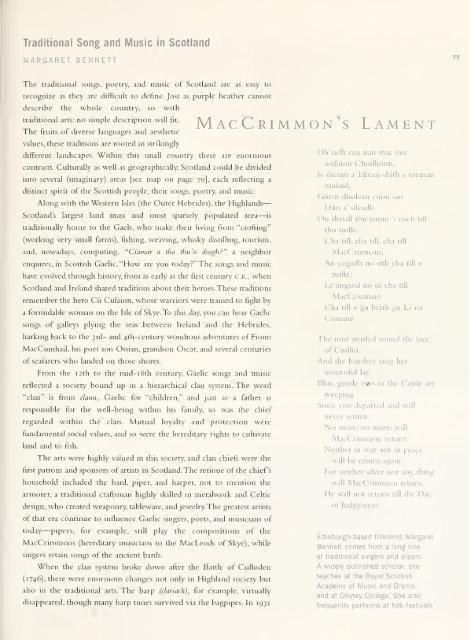SCOTLAND - Smithsonian Digital Repository - Smithsonian Institution
SCOTLAND - Smithsonian Digital Repository - Smithsonian Institution
SCOTLAND - Smithsonian Digital Repository - Smithsonian Institution
Create successful ePaper yourself
Turn your PDF publications into a flip-book with our unique Google optimized e-Paper software.
— 1<br />
Traditional Song and Music in Scotland<br />
MARGARET BENNETT<br />
77<br />
The traditional songs, poetry, and music of Scotland are as easy to<br />
recognize as they are difficult to define. Just as purple heather cannot<br />
describe the whole country, so with<br />
traditional arts, no simple description will fit.<br />
The rruits or diverse languages and aesthetic<br />
MACCRIMMON'S LAMENT<br />
values, these traditions are rooted in strikingly<br />
different landscapes. Within this small country there are enormous<br />
contrasts. Culturally as well as geographically, Scotland could be divided<br />
into several (imaginary) areas [see map on page 70], each reflecting a<br />
distinct spirit of the Scottish people, their songs, poetry, and music.<br />
Along with the Western Isles (the Outer Hebrides), the Highlands<br />
Scotland's largest land mass and most sparsely populated area—is<br />
traditionally home to the Gaels, who make their living from "crofting"<br />
(working very small farms), fishing, weaving, whisky distiUing, tourism,<br />
and, nowadays, computing. "Ciamar a tha thu'n diugh?" a neighbor<br />
enquires, in Scottish Gaehc, "How are you today?" The songs and music<br />
have evolved through history, from as early as the first century C.E., when<br />
Scotland and Ireland shared traditions about their heroes. These traditions<br />
remember the hero Cu Culainn, whose warriors were trained to fight by<br />
a formidable woman on the Isle of Skye. To this day, you can hear Gaehc<br />
songs of galleys plying the seas between Ireland and the Hebrides,<br />
harking back to the 3rd- and 4th-century wondrous adventures of Fionn<br />
MacCumhail, his poet son Ossian, grandson Oscar, and several centuries<br />
of seafarers who landed on those shores.<br />
From the 12th to the mid- 1 8th century, Gaelic songs and music<br />
reflected a society bound up in a hierarchical clan system. The word<br />
"clan" is from dann, Gaelic for "children," and just as a father is<br />
responsible for the well-being within his fanuly, so was the chief<br />
regarded within the clan. Mutual loyalty and protection were<br />
fundamental social values, and so were the hereditary rights to cultivate<br />
land and to fish.<br />
The arts were highly valued in this society, and clan chiefs were the<br />
first patrons and sponsors of artists in Scotland. The retinue of the chief's<br />
household included the bard, piper, and harper, not to mention the<br />
armorer, a traditional craftsman highly skilled in metalwork and Celtic<br />
design, who created weaponry, tableware, and jewelry. The greatest artists<br />
Dh'iadh ceo nan stuc mu<br />
Is<br />
aodainn Chuillionn,<br />
sheinn a" bhean-shith a torman<br />
mulaid,<br />
Gorm shuilean ciuin san<br />
Dun a' sileadh<br />
On thriali thu uainn 's nach till<br />
thu tuille.<br />
Cha till,<br />
cha till, cha till<br />
MacCriomain,<br />
An cogadh no sith cha till e<br />
tuille;<br />
Le airgiod no ni cha till<br />
MacCriomain<br />
Cha till<br />
Cruinne.<br />
e gu brath gu La na<br />
The mist swirled round the face<br />
of Cuillin<br />
And the banshee sang her<br />
mournful lay.<br />
Blue, gentle eyes in the Castle are<br />
weeping<br />
Since you departed and will<br />
never return.<br />
No more, no more, will<br />
MacCrimmon return<br />
Neither in war nor in peace<br />
will he return again;<br />
For neither silver nor any thing<br />
will MacCrimmon return.<br />
He will not return till the Day<br />
ofJudgement.<br />
of that era continue to influence Gaehc singers, poets, and musicians of<br />
today — pipers, for example, still play the compositions of the<br />
MacCrimmons (hereditary musicians to the MacLeods of Skye), while<br />
singers retain songs of the ancient bards.<br />
When the clan system broke down after the Battle of CuUoden<br />
(1746), there were enormous changes not only in Highland society but<br />
also in the traditional arts. The harp (clarsach), for example, virtuaUy<br />
disappeared, though many harp tunes survived via the bagpipes. In 193<br />
Edinburgh-based folklorist Margaret<br />
Bennett comes from a long line<br />
of traditional singers and pipers.<br />
A widely published scholar, she<br />
teaches at the Royal Scottish<br />
Academy of Music and Drama,<br />
and at Orkney College. She also<br />
frequently performs at folk festivals.
















